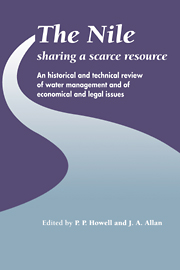 The Nile: Sharing a Scarce Resource
The Nile: Sharing a Scarce Resource Book contents
- Frontmatter
- Contents
- Preface
- List of Contributors
- Orthography
- Units and Conversion Factors
- Introduction
- I Environmental history of the Nile and its management
- II Nile management and factors affecting future management
- III Future utilisation of Nile waters
- IV Economic, international and legal issues
- 14 Evolving water demands and national development options
- 15 The Nile Basin: water management strategies
- 16 History of the Nile Basin and Lake Victoria basins through treaties
- 17 Principles and precedents in international law governing the sharing of Nile waters
- 18 Law and the River Nile: emerging international rules and the Sharia'h
- 19 Developing policies for harmonised Nile Waters development and management
- Index
16 - History of the Nile Basin and Lake Victoria basins through treaties
Published online by Cambridge University Press: 05 February 2012
- Frontmatter
- Contents
- Preface
- List of Contributors
- Orthography
- Units and Conversion Factors
- Introduction
- I Environmental history of the Nile and its management
- II Nile management and factors affecting future management
- III Future utilisation of Nile waters
- IV Economic, international and legal issues
- 14 Evolving water demands and national development options
- 15 The Nile Basin: water management strategies
- 16 History of the Nile Basin and Lake Victoria basins through treaties
- 17 Principles and precedents in international law governing the sharing of Nile waters
- 18 Law and the River Nile: emerging international rules and the Sharia'h
- 19 Developing policies for harmonised Nile Waters development and management
- Index
Summary
Introduction
This chapter is concerned with the history of the treaties for the consumptive utilization of one of the world's largest fresh water basins. Lake Victoria is the second largest fresh water lake in the world after Lake Superior (assuming the waters of the latter can still be considered fresh). The Nile is the longest river in the world. Both basins together are bordered in different degrees by nine states, namely: Kenya, Tanzania, Uganda, Ethiopia, the Sudan, Egypt, Zaire, Burundi and Rwanda. The status of the last two is unique in that they are brought into the basin by virtue of the Kagera River, which drains into Lake Victoria. The entire basin area has been estimated at 2.9 million square kilometres, which represents approximately one tenth of the continent.
Despite these superlatives, the water of the basins or drainage system, is a scarce resource in more than one sense. First, the Nile is a source of livelihood for the desert states of Egypt and the Sudan. A review of the treaties on the consumptive utilization of the Nile and Lake Victoria will show how Egypt has strenuously sought to ensure security of the water flowing down the Nile.
Second, the water is not evenly distributed upstream either over the year or geographically. For instance, Ethiopia contributes approximately 85 per cent of the volume of water which flows annually past Khartoum.
- Type
- Chapter
- Information
- The Nile: Sharing a Scarce ResourceA Historical and Technical Review of Water Management and of Economical and Legal Issues, pp. 321 - 350Publisher: Cambridge University PressPrint publication year: 1994
- 6
- Cited by


